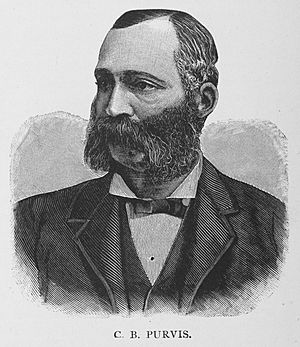Charles Burleigh Purvis facts for kids
Quick facts for kids
Charles B. Purvis
|
|
|---|---|

Purvis in 1887
|
|
| Born | April 14, 1842 |
| Died | December 14, 1929 (aged 87) |
| Occupation | physician |
| Political party | Republican |
| Parents |
|
| Relatives | Harriet Purvis, Jr. (sister) |
Charles Burleigh Purvis (born April 14, 1842 – died December 14, 1929) was an important doctor in Washington, D.C.. He helped start the medical school at Howard University. He was the first African American doctor to care for a sitting president, James Garfield, after he was shot in 1881.
That same year, Purvis became the first African American doctor to lead a hospital not run by the military. This was at the Freedmen's Hospital. He was also the first African American to serve on the D.C. Board of Medical Examiners. Plus, he was the second African American teacher at an American medical school. Charles Purvis was also a strong supporter of civil rights and the right for everyone to vote.
Charles Purvis's Early Life
Charles Purvis was born in Philadelphia on April 14, 1842. His parents, Robert Purvis and Harriet Forten Purvis, were both free people of color and worked to end slavery. When Charles was two, his family moved to Byberry, a town near Philadelphia. Charles was the fifth of eight children. He helped out on the family farm when he was young.
He went to some public schools. But most of his early education was with the Quakers. In 1860, he started college at Oberlin. He studied there for two years but did not finish. In 1862, he began studying medicine at Western Reserve in Cleveland.
Charles Purvis's Medical Career
In 1864, during the U.S. Civil War, Purvis worked as a military nurse for the Union Army. He was at Camp Barker, which later became a model for Freedmen's Hospital. He finished his medical training and graduated from Western Reserve in March 1865. Just two months later, he became an acting assistant surgeon with the rank of first lieutenant. He was sent to Washington, D.C., and worked in this role until 1869.
On June 9, 1869, Purvis and another doctor, Alexander Thomas Augusta, tried to join the Medical Society of D.C. This group was part of the American Medical Association. Even though they were qualified, they did not get enough votes to join. Another African American doctor, A. W. Tucker, was also rejected later that month. Because of this, these three doctors started their own group, the National Medical Society, for African American doctors.
Purvis and Alexander T. Augusta were among the people who helped create the Howard University Medical School. In the fall of 1868, Purvis became a professor there. He taught about medicines and medical law for five years. After that, he became the head of the department for childbirth and diseases of women and children. He was also chosen as the secretary for the Medical Faculty. Purvis was very successful at Howard. He is given credit for keeping the medical department running during a difficult time in 1873.
He cared for President Garfield after an assassin shot him on July 2, 1881. This made Purvis the first African American doctor to treat a sitting president. Later in 1881, President Chester A. Arthur chose Purvis to be the Surgeon-in-Charge at Freedmen's Hospital. He worked in this role from October 1, 1881, until 1894. This made him the first African American to lead a hospital that was not run by the military. Purvis later said he believed he was removed from this job because of political changes.
In 1904, Purvis received a license to practice medicine in Massachusetts. He also joined the Massachusetts Medical Society. In 1905, he moved to Boston. Purvis left his teaching job at Howard University medical school on May 28, 1907. He was given the title of professor emeritus on January 21, 1908, which means he was honored for his past work. Purvis had first started teaching at Howard in 1868. On May 24, 1908, he was elected to Howard's Board of Trustees. He served on the board until he resigned on June 1, 1926.
Other Important Activities
In Washington, D.C., Purvis was good friends with many important leaders. These included Frederick Douglass, Francis James Grimké, Blanche Bruce, and Richard Theodore Greener. In 1881, Purvis joined James Monroe Gregory and George T. Downing to fight against a proposed law. This law, being discussed in the U.S. House of Representatives, would have created separate schools for African American children.
The three men created an organization to fight this unfair treatment. Many civil rights leaders joined this group. Frederick Douglass was the president, and Richard T. Greener was the secretary. Other members included Frederick G. Barbadoes, John F. Cook, Francis James Grimké, Milton M. Holland, Wiley Lane, William H. Smith, Purvis, Downing, and Gregory. A representative named Dudley C. Haskell also supported the group. They were successful in stopping the proposed law.
Purvis was also a member of the Masons, a fraternal organization. He was the first African American person to serve on the D.C. Board of Medical Examiners. He was also the second African American teacher at an American Medical School. Howard University gave him an honorary law degree (LL.D.) in 1914.
Purvis, along with his father and many others, was active in movements for women's rights and the right for everyone to vote. Some people criticized Purvis because he had light skin, married a white woman, and sent his daughter to public schools that were mostly for white children in D.C. They felt he should have focused only on African American issues.
Purvis married Ann Hathaway on April 13, 1871. They had two children. Their daughter, Alice, became a doctor, and their son, Robert, became a dentist. Charles Purvis died in Los Angeles, California, on December 14, 1929.

